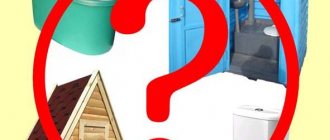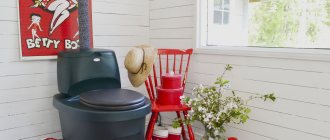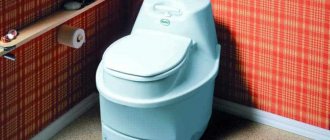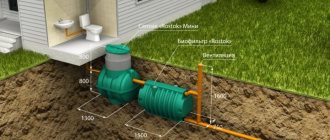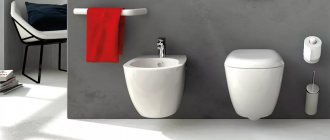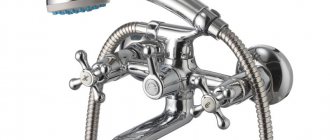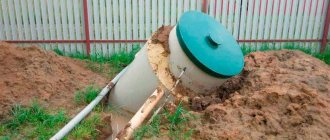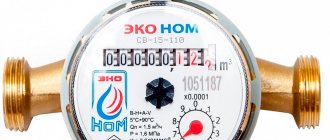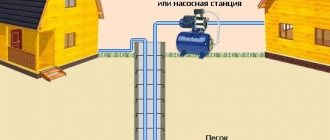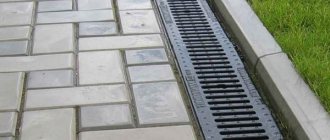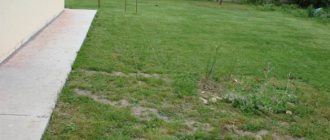Review
“I’ve had Separett Villa installed for a year now, in the summer it’s generally great, no smell, no problems - 1 but we need to make sure that the liquid drain pipe
the faction is not clogged, otherwise there will be a serious accident - the place where the bucket is installed will flood and that’s it, scooping it out is an awesome pleasure - I checked it the hard way (it clogged due to a design error in the pit on the street), after that there were no accidents! It works great in winter, nothing freezes in the pit, everything is great! There is no noise or smell at all (the smell appears in the summer near the house during the wind due to the side outlet of the ventilation pipe under the roof - this year I will raise the pipe higher! I use garbage bags and then throw the contents into the trash can (everything is relatively dry there and does not smell almost nothing), the garbage really stinks stronger =) When the power is turned off. I don’t bother with energy - I open the toilet and put the lid on the tank from the kit and that’s it =) There will be a battery this year. In short, as happy as an elephant. "
Advantages and disadvantages
If you decide to install a Finnish peat dry closet for your dacha, then you need to understand what advantages these designs have:
- Small dimensions.
- The dry closet operates autonomously, so there is no need to connect the power grid or utilities.
- Environmental Safety.
- Possibility of obtaining high-quality organic fertilizer.
The video shows the advantages of a peat toilet for a summer residence:
But peat models have their disadvantages. These include the need to monitor the level in the storage tank, as well as periodic cleaning of the tanks. But such disadvantages are not typical for all types of Finnish peat toilets.
You can see what two-room country cottages with a toilet and a veranda look like in the photo in the article.
But what is the best peat toilet to use for your dacha? This information will help you understand.
What a toilet looks like in a country house with a toilet, and how it can be made. The information from the article will help you understand: https://2gazon.ru/postroiki/biotualety/tualet-na-dache-s-unitazom.html
You may also be interested in learning how to choose the right dry closet for your dacha.
Review
I also use Piteko 505. I’ve adapted to spreading peat: I turn it smoothly in one direction or the other, and it falls asleep decently. The nuts have not yet been loosened, apparently the assembler was caught by a normal person and did not tighten the nuts. The container is also not very easy to remove, despite the cut in the lower pipe, but I have adapted: I don’t load more than half of the container, so it’s easier to get it out. Well, on the other hand, the managers offered me to buy a completely problem-free Biolet Multoa, but its price is such that I decided that for my change house Piteko 505 is an ideal option, even if sometimes I throw in peat with a scoop, the main thing is that there are no flies and no smell!
Advantages
The Kekkila ecomatic peat toilet has gained popularity among consumers due to a number of advantages:
Characteristics of the Ecomatic-50 Kekkila toilet
- strength, reliability, durability, based on high quality products;
- cost-effectiveness, since there is no need to purchase expensive biological or chemical preparations;
- Possibility of use in different rooms;
- versatility, since the dry toilet of the famous brand Kekkila ekomatic 50 operates without electrical power and does not require a water supply;
- clean air thanks to ventilation;
- simple emptying procedures;
- affordable price for wide categories of citizens;
- compactness;
- comfortable seat equipped with a folding lid.
The compact dry toilet from the Kekkila ekomatic 50 product line is attractive to summer residents. This is due to the fact that sewage, entering the container, is immediately included in the composting process, yielding organic fertilizer. A volume of 50 liters allows a family of four households to use the dry closet for a month without emptying the container.
Peat toilet Ekomatic 50 Kekkila
Review
“I bought the same one over the weekend (Piteco 506). I received a modification with a different handle for the peat spreader - as in Fig. in the passport (see photo). I don’t know if this is worse or better - I suspect that I’ll still have to throw the peat with a scoop. The plastic of the body and container seems a little flimsy. Ventilation pipes are included, you will have to come up with a replacement. So far the only thing that comes to mind is to buy a 75mm sewer pipe. Maybe there are some other options? Although the first elbow will have to be left if the internal container cannot be pulled out without moving it, as SergeyAS writes.”
Description and characteristics
Kekkila peat composting toilet in design
An innovative composting toilet under the Kekkila brand with a volume of 50 liters has a rotating internal container. This design is intended for the safe disposal of waste in conditions where it is impossible to connect to a central sewer system. This device becomes an ideal solution in a country house where permanent residence is not expected and it is not economically profitable to install a septic tank.
Advantages of the Ecomatic-50 Kekkila toilet
The main parts of the peat toilet are made of durable composite materials of the latest generation, which ensures a long service life. Wood fiber and polypropylene are used for the seat and lid, and fiberglass and polypropylene are used for the body. The design includes an outlet to which a ventilation pipe is connected, as well as a fitting designed to remove the liquid fraction of waste.
The drive used to rotate the movable internal container, as well as five rollers, are made of polyoxymethylene, a material with high strength, resistance to abrasion and impact loads. For the manufacture of the inner container, the manufacturer uses polypropylene, known for its resistance to corrosion and long service life.
Thanks to its width of 500 mm and depth of 510 mm, the Kekkila ekomatic 50 brand dry toilet easily fits into small spaces. The height of the product is 470 mm. Its weight is only 7 kg. The package does not include a drainage hose, a ventilation pipe, an adapter elbow, or a container in which liquid waste is collected. These devices are purchased in the required sizes, depending on the dimensions of the room.
The housing cover is removable for emptying the filled container. Dry high-moor peat is used as a composting material. You can purchase ready-made mixtures under the Kekkila brand.
Review: Andrey P.
“I can share my impressions of Ekomatic during the season. It is located on my veranda at home, I made a separate small booth there, I’m tired of running outside, especially in the morning and when it’s raining or frozen. Start of operation on May 9 this year. The three of us used it mainly on weekends and vacations, and sometimes friends came over. In the hot summer there were no smells on the veranda, but in the cabin itself there was sometimes a slight smell of ammonia and to remove it I bought an automatic air freshener, which works every time you visit this device. I emptied it twice a season, the first time in August, and the second time before the dacha season closed for the November holidays, I decided not to leave this “good” until spring. When I took it out for the first time, it was 2/3 full, it weighs quite a bit, but my wife and I easily loaded it onto a wheelbarrow and took it to the compost heap, there was no smell of shit, just a couple of drops dripped from the drain hole of the drainage hose. As for the consumption of peat and sawdust, at first the consumption was decent, but then I started pouring no more than 1/4 into the tank and turning the handle no more than half a turn. I can sum it up, this is my personal opinion, of the advantages, it does not require frequent removal compared to a bucket, it can be placed in a living room, there is no smell and you don’t have to put on cotton pants or a raincoat in the morning to run to it (if you manage to run there). The only downside I see is that it still needs to be taken out and emptied. In general, I’m completely satisfied with the toilet, and I’m not the only one.”
Manufacturers and prices
Today, Finnish peat recyclers are available in a wide range. Thus, choosing the necessary model will not be difficult. The main thing is to trust trusted manufacturers.
Ecomatic
This manufacturer suggests models of a Finnish peat dry closet, the operation of which involves the use not of pure peat, but of a peat mixture with sawdust. In this way, it is possible to obtain oxygen in the amount necessary for the formation of fertilizer.
From Ecomatic
But Ecomatic dry closets have their drawbacks. The first disadvantage is the high cost. But on the other hand, dry closets have an attractive appearance, so they will fit seamlessly into a summer cottage.
The next advantage of such designs is the large capacity of the tank, which is 110 liters. Due to this volume of the tank, comfortable operation of the device is achieved by a family of 4 people. The dry closet needs to be cleaned every 2 months. The cost of the Ecomatic dry closet is 21,900 rubles. But what is the most popular dry toilet for a summer cottage without odor and pumping, and how to choose it correctly. This video will help you understand.
Piteko
This is another popular manufacturer of Finnish peat toilets. Produces them in Russia. They must be installed on a hard and level surface. But there is no need to connect the electrical network and utilities.
From Piteko
The peculiarity of dry toilets of this brand is that they have two-chamber designs. This makes it possible to separate waste into liquid and solid. Recyclers can also be equipped with filters for removing liquid and flaps for convenient removal of compost. You can purchase a 44 liter Piteko waste disposal unit for 5,490 rubles. But how to choose a toilet in a country house without a cesspool, and what it will look like, will help you understand the video from the article.
Biolan
This manufacturer produces expensive models of Finnish dry toilets. Options with two-chamber utilizers, in which liquid and solid waste are distributed, are in great demand. When installing such structures, no connection to the electrical network or sewer system is required.
From Biolan
Models are equipped with a ventilation pipe with a cover. Thanks to it, you don’t have to worry about unpleasant odors entering the room. This brand produces dry toilets with an improved drainage system. The model range includes several options, but the maximum tank capacity is 300 liters. The cost reaches 19,500 rubles. But what a country toilet and shower made of brick will look like, and how you can build it yourself, is described in great detail in this article.
Review:
Impressions from the first day of using the latest model of the Compact-Premium peat dry closet : + sit comfortably - you need to ask the manufacturer to fill the flush/fill tank with peat, because you are unlikely to succeed (especially considering that the peat sold is damp and likes to stick together) ... so a bucket of peat + a scoop - RULES + odors (after filling up big things) - no, after small things you don’t have to pour it in - declared peat consumption (1 bag 7 kg for 2 people per season) - lie... I don’t know how to put it mildly: first there is a mound at the bottom, a mound in the tank, and then sprinkle your work, in general, from 3 purchased 7-kg bags for 20 hours of stay 1.5 bags left - a spinner for filling - nonsense, because... in the tank on the far wall the peat sticks together and hello... you have to knock on the tank My rating is 4
Description of the Finnish peat toilet
Finnish dacha dry closets are unique designs that can be completed with your own efforts. Their peculiarity is in the method of loading the neutralizing material. If we compare a peat toilet with a chemical one, then the first option does not require refilling with active materials at a time until it is used up. Each layer of waste is covered with peat, which ensures extremely tight contact and effective compost formation.
You can fill the peat manually. This method has found application when installing home-made structures. A container with dry peat and a scoop is mounted along with it. It is necessary to fill up the sewage after each visit to the toilet.
Video: description of the operation of a composting toilet for a summer residence
In the video - a Finnish peat toilet for a summer house:
If we consider factory models, they are equipped with dispensers. In them, peat is located in special containers. Thanks to the dispenser, economical consumption of the product is achieved. If you buy innovative models of Finnish peat toilets, they have a dispenser with a distributor. Due to this, the peat will be distributed evenly over the waste. Maybe
Review:
I have been using Ecomatic for several years now. Fine.
Proper use involves the use of peat. It must be placed in a special compartment. You twist the handle and the peat inside crumbles into an even layer. Beauty ! You can take the same peat with your hand (with a scoop) and aim it inside. This way, by the way, less peat is consumed. When the peat runs out, you can use sawdust. (the best results were obtained from a mixture of poplar and birch sawdust). In this case, the use will not be entirely correct. But you don't need to buy anything. A slight smell may appear (this is understandable - sawdust is not peat). Although it all depends on the specific users. And from what they ate. About the flies. The appearance depends on the frequency of removal of the contents and the weather. For some reason there are no flies in winter. By the way, about winter. In winter, the contents of the container freeze safely. Peat in a special compartment too. Therefore, it is better to use your hand or a scoop. Thaws in the spring. Well, or a thaw will happen. So be sure to empty it before the cold weather. After emptying, I rinse with water. I just rinse. Cleans up well. The plastic is slippery and nothing sticks to it much. Overall I'm happy. PS For the sake of experiment, I added waste from the coffee machine. The result is great. You open the lid and it smells like coffee! Another plus of the toilet is that it works on any raw material - peat, sawdust, coffee waste...
Which dry toilet is better to buy?
It all depends on the scope of application. For patient care or short trips, the best option would be lightweight, portable liquid dry toilets (for example, Thetford porta potti 365 - the leader in popularity among dry closets). For summer cottages, peat composting toilets are most often chosen. If we are talking about long-term residence outside the city, but there is no opportunity to install a sewer system, then larger models will help. Well, for those who are not used to denying themselves anything, an electric dry closet would be an excellent solution.
Happy shopping!
Conclusion
Summer residents have the right to choose a dry closet at their own discretion. If the outdoor toilet is built well, and there are no problems with night trips “after the wind,” then you can use bacteriological outdoor toilets. But if comfort requires installing a toilet in the house, then they choose one of the above models. From consumer reviews it is clear that the peat and electric versions of the dry closet are the most acceptable options, and are also beneficial for the garden. A portable chemical unit requires refilling and regular pouring of liquid from the container. However, what to buy is up to you!
Conditional separation of dry toilets
Information about the modifications and models of such structures, as well as reviews of dry closets for the dachas of direct consumers, will help you understand the variety of products that the industry offers. The dry closets available for sale today are divided into 4 groups:
- bacteriological;
- chemical;
- peat;
- electric.
In scientific circles, chemical portable toilets are excluded from the category of dry toilets due to the presence of chemicals. And in real dry closets, the disposal of human waste should occur only through natural materials and microorganisms (peat, sawdust, microflora). We, ordinary residents, consider such chemical toilets to be the very best - dry toilets, citing not the natural nature of waste cremation, but mobility and practicality. The industry of all countries contributes to the development of chemical toilets, providing them with better characteristics, convenience, and design (Figure 1,2,3). With such helpers, it’s not scary to go on a road trip by car to a remote village.
Refilling a chemical toilet Fig. 3
peat dry closet Fig. 4
Installation
The Kekkila ekomatic 50 type of dry closet is installed in various buildings - a toilet house, a separate room in a country mansion on a hard surface that must be flat. For temporary use, you can put it in any barn.
Preparation for installation of the Kekkila Ecomatic-50 dry closet
When carrying out installation work, you must follow all instructions. This will prevent unpleasant odors from entering the room. Leveling the floor plane before installing the composting toilet ensures that the liquid separated during the composting process completely drains into the drainage system. The housing, due to its good stability, does not require additional fixation to the floor.
Emptying
In order for the Kekkila brand peat dry closet, which has a storage capacity of 50 liters, to function properly, it must be emptied in a timely manner.
Components of the Ecomatic dry closet
- The container is rinsed with water and placed in an open place for a while to dry.
- To prevent any remaining liquid from contaminating the floor and clothing, it is advisable to immediately place the container in a large bag after removal, using, for example, a plastic garbage bag.
- The contents of the container are sprinkled evenly with a two to three centimeter layer of peat mixture on top.
- The cover is removed.
- Carefully remove the inner container.
- All that remains is to take the container from the dry closet to the place in the garden chosen for collecting compost and empty its contents.
- Drainage holes are checked. If they are clogged, then cleaning is carried out.
All that remains is to put the clean container back inside the body of the dry closet and install the lid. When using waste as organic matter to improve soil fertility, it is necessary to keep it in a compost pit for at least two years. At the same time, leaves, weeds, and used mulch are poured into it to obtain complete fertilizer. It is more convenient to clean the dry closet early in the morning, when it has not yet been used. In this case, there will be less liquid in the container.
